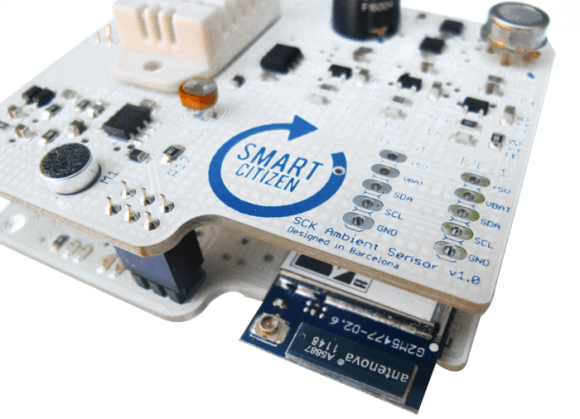
If you’re going to develop another Arduino-compatible board these days, you might as well take a “kitchen sink” approach. The Smart Citizen Kit piles it on, including Wi-Fi, an SD card slot, and EEPROM on its base. The attached shield—dubbed the “Ambient Board”—is a buffet of sensors: temperature, humidity, CO, NO2, light intensity, and a microphone for reading sound levels. The board’s intended purpose is to provide an open-source, interactive, environmental database by crowdsourcing data from multiple Smart Citizen Kits, but you can add your own stuff or yank the shield off altogether. Additional shields are also under development, aimed at providing agricultural data, monitoring biometrics, and more.
Stick the Smart Citizen somewhere and it can send sensor data to the web over a WiFi connection. The result is worth a look. Here’s the map with the real-time data from early release models scattered over Europe, most of which appear to be solar-powered with a small LiPo battery to keep them going overnight. There’s also an accompanying iPhone app that lets you set up the Smart Citizen, retrieve data from nearby sensors, and allows you to match your phone’s GPS location to any data you collect while carrying the board around.
The developers met their Kickstarter goals earlier this summer and the board has recently entered the manufacturing process, Rummage through their GitHub files here, and watch a video preview of the Smart Citizen below.
















I like it. but it will be more intresting if include lcd screen with user interface.
It looks like AirPi.
http://airpi.es/
So I took a closer look.
Smart Citizen: Target price $150
CO
NO2
temperature
humidity
light level
soundlevel
AirPi: Price $90 + a Raspberry Pi = about $125
CO
NO2
temperature
humidity
light level
UV level
air pressure
Interesting to see two very similar projects.
Similar in terms of sensors, but my guess is that it is easier to run the SmartCitizen as a wireless sensor node since it 1) has built in WiFi 2) lower power requirements 3) hardware support for a PV panel and battery backup.
Hiya – I’m the creator of the AirPi. I think, in a way, the two projects are designed for different purposes. The AirPi is super hackable – you can pipe the data wherever you like, modify it on the Raspberry Pi or set triggers for it online. But you have to install code on the Pi to get it to work, etc. This, on the other hand, seems to be much more turn-on-and-go solution – sort of like the Air Quality Egg which popped up last year. I do like the solar concept, planning on integrating that into my next project. Also, fun fact, but we’re nuking the UV sensor and replacing with a volume level sensor. It was simply too unreliable, prone to failure, and all around kinda useless.
Their web design is absolutely superb – I love it.
The hardware is also totally open-source check it at github. you can even reuse the main board without the sensor board for any other IOT project you’ll like to do, here is the pinout.
The writeup says it measures co2 levels, while the site says co levels, which is it?
Am I correct in thinking there is a difference in measuring carbon dioxide and carbon monoxide? I am interested in a CO2 detector, while a CO detector interests me not at all, as a hydroponic enthusiast.
My mistake; it’s a typo. Should be CO. Fixed.
No worries mate, I wonder what it would take to get a CO2 sensor on the board too?
Money.
On more serious note, I tried some time ago to read SenseAir K22 I2C sensor using RPi but did not get very far because either the timing is very critical or I missed some additional resistor in RPi side.
What is the difference, for us chemistry impaired?
They do make a pretty website
Would be cool to see natrual gas and propane on there too.
Yeah, where’s the fart detector???
If you have propane in the area you don’t want an electrical thingy near it though :)
Actually if there is natural gas in the area you don’t want any ignition sources around either, if the gas can’t dissipate fast enough. Anyway such a detection capability doesn’t seem to fit within the projects goal yet. When time monitoring the methane levels in the atmosphere become important we are pretty much screwed
Have you looked at the data? Why is everything cycling like crazy? Even the noise level cycles in the middle of the night? May be it’s the bulls running up and down the streets in Spain?
Weekend in Barcelona
I read the title as ’Senior Citizen’
Did you read it that way because you are a senior citizen? ;)
I like how they just stick the board out in nature. It wouldn’t last a day like that where I live
While I like the goal of collecting as much environmental data possible in as many locations possible. Unless the units are easily and accurately calibrated initially and as easily kept in calibration any data they collect will be easily dismissed by those in a position to actually do anything to protect the environment we all depend on to live. How secure will the wireless side be from spoofing by those with an interest in skewing the results one way or another? I admit I may overlook those answers while looking at the project information.